|
FAQs about Naso
vlamingii
Related Articles: Naso Species
Tangs by Bob Fenner, Lipstick
Tangs, Surgeonfishes/Tangs/Doctorfishes and Marine
Aquariums,
Related FAQs: Nasos, Nasos
2, Nasos 3, & Naso ID, Naso
Behavior, Naso Compatibility,
Naso Selection, Naso Systems, Naso Feeding, Naso Disease, Naso Health 2, Naso Reproduction, Surgeons In General, Tang
ID, Selection,
Tang
Behavior, Compatibility, Systems, Feeding, Disease,
|
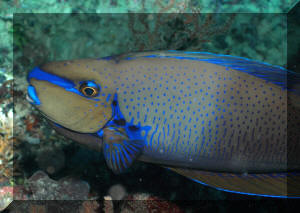
|
Surgeonfishes: Tangs for Marine Aquariums
Diversity, Selection & Care
New eBook on Amazon: Available here
New Print Book on Create Space: Available
here
by Robert (Bob) Fenner |
 |
|
Sick Vlamingi Tang 4/28/15
Dear WWM Crew,
<Nancy>
I am a former Local Fish Store owner and pretty good on the basics of Saltwater
Fish Keeping. I believe in regular water changes (RO only), a high nutrition
diet of quality foods, no nets used (only plastic specimen containers), good
flow in the tank, appropriate sized tank for the inhabitants, etc..etc...
Generally, I do my best to provide a top quality environment.
<Ok... see in your pix evidence of neuromast destruction; HLLE in
petfish parlance. Have you read on WWM re? The principal "causes"....
avitaminoses, pollution... Octomita>
Would you please help my poor Vlamingi Tang? I'd like to start him on some kind
of medication soon but need more help first. Here is the background to date:
*April 2014 History:*- Last year at my store... Vlamingi was infected by a
Sailfin Tang who came in with ick and some disease that was making the Sailfins
face flake and peel away. The Sailfin died but the Vlamingi survived.
- We took him home and treated with Metronidazole & Focus from SeaChem and he
got better, completely cleared up.
- He was housed in a 90 gallon reef tank with community, peaceful tankmates, no
troubles. Tankmates: Blue Face Angel, Scott's Fairy Wrasse, Goldenhead Goby,
Chromis, Chrysus Yellow Wrasse, Clownfish, coral banded shrimp pair and 1 blood
red fire shrimp.
- No other bouts of disease or even ick. No new fish added to this group.
*2015 Currently:*- 9 months later... Val outgrows the 90!
- We stood up a 200 Fowlr in early February, cycled 6 weeks with live rock and
water changes from our 90 and 30 gal other tanks. Then, Vlamingi moved in with
the same tankmates from the 90.
- Everything going fine except for the cyanoBACTERIA creeping up on the rocks
lately, in April.
<Could indeed be a if not the factor here>
There is a lot of flow in the tank and I try not to overfeed (I watch everyone
eat pellets and frozen foods)
- When the nitrates climbed a bit and we missed a water change, the
Scott's Fairy Wrasse broke out in ick. After a 20% WC, he got much better, ick
disappeared.
<Evidence of what.... borderline water quality issues>
- The first sign of disease appeared on Val around the end of March, on right
side of his face.
- Then, right side got a little better but left side broke out into a large red
pimple type, mid-April.
- Now, end of April, both sides better but not really... seems to be spreading
to his lips and near gills. Today, 4/27/15, it looks even worse
:-(
- Val's behavior and all the other fish are completely normal. No one is
flashing, scratching, hiding or aggressive. All are eating normally.
*Tank parameters:* 200g FOWLR only right now
- 1.022 salinity
<Too low>
- .2 nitrates, 0 ammonia
- 10-20% water change every week using RO water and Red Sea Coral Pro Salt
(which was used in the 90 reef tank, so that's what the fish are used to)
- White LED lights on aprox 8 hrs, then Blues for aprox 2 hrs
- 2 powerheads and 2 returns providing a lot of water flow and movement (we turn
off the powerheads at night so fish can rest)
- decent amount of base rock in the display, lots of hiding places and everyone
seems happy with their territories
- 36" sump holds live rock, 2 filter socks, media sponge and occasional carbon
or phosphate remover media. (I had to use carbon to take out StressGuard that we
tried when the Val's disease first appeared, we thought it was a minor injury
and wanted to replenish his slime coat to help healing...no effect except
screwed up the skimmer and hard to get the tank
back to normal)
- only RO water ever used, never use tap water
- we are adding a UV sterilizer to the tank, now that the bacterial cycle is
established
- we are also using 2 Little Fishies NPX Bioplastics in a DIY reactor
(nitrate and phosphate reducing biodegradable polymers)
<Not a fan>
- Fish Diet: seaweed 2x a day, garlic & Selcon soaked Mysis Shrimp 2x a week,
daily New Life Spectrum Thera Garlic pellets, Cobalt Algae pellets, and
occasional fresh spinach/kale/lettuce for Val.
**** I am attaching 6 photos in this email showing the disease progression.*
**** Here is a link for 2 videos on YouTube that might help get the full
scenario.*
*https://www.youtube.com/channel/UC67Rpb5HqP-FWb1l5AEjZqw/videos
*or try this link:
https://youtu.be/bcderjUnwtk
<https://youtu.be/bcderjUnwtk>*
I would really appreciate your opinions; feel free to call me to discuss
anytime.
Thank you in advance!!!
Nancy Coughlin
<The reading... spiffing up your water quality, supplementing foods, the
comments above. Bob Fenner>
|
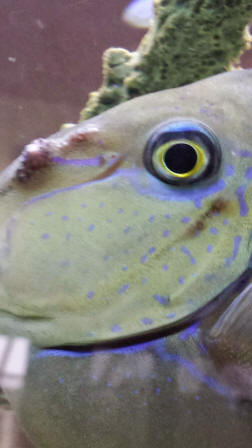
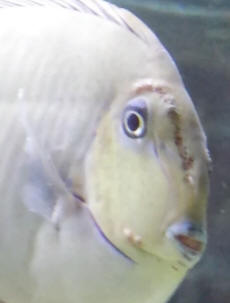 |
|
Re: Sick Vlamingi Tang 4/28/15
Thank you for your very speedy reply, Mr. Fenner! It's an honor to speak with
you.
<Glad to share>
Could the problem possibly be Lymphocystis?
<Mmm; not really; or better put: Most all such cases are due to the same sorts
of stressors... poor environment (a huge set of possibilities: chem. phys. and
social), lack of and/or poor nutrition >
I'll take your recommendations:
- raise salinity... to 23 or 24? This is fish only.
<1.025-6>
- perform water changes more frequently and in larger quantities (30% weekly, 60
gallons, 2 brutes)
<Good idea>
- we can remove the NPX Bioplastics... it was only for cycling the tank
initially
<Yes; try Chemipure, Polyfilter instead>
- fix the cyanoBACTERIA (not sure what else to try, short of treating the tank
with a chemical, which I'm not keen on)
<READ on WWM re means of thwarting BGA... VERY important at times>
What do you think of the foods I'm using? (Fish Diet: seaweed 2x a day, garlic &
Selcon soaked Mysis Shrimp 2x a
week, daily New Life Spectrum Thera Garlic pellets, Cobalt Algae pellets, and
occasional fresh spinach/kale/lettuce for Val.)
<These are mighty fine>
Did I miss any other suggestions?
<Rods, LRS...>
Thanks again!!!
Nancy
<As many welcomes. BobF>
|
Vlamingi in a 4 foot tank 9/16/13
I have the opportunity to buy a Vlamingi that is 11 inches long
and has been in captivity 11 years.
<Neat Naso species>
I have a 270 gallon tank, but it is only 4 feet long (48"x48"x28").
I know these get nearly 2 feet long, but after 11 years in captivity, I
doubt he will grow much.
<Agreed>
Do you think I should give this a try? Or should I hope he finds a
larger home?
<A bigger, esp. longer world would be much better; and w/o knowing what
your other livestock are, I would definitely NOT encourage this
addition.
Bob Fenner>
Vlamingii Pecking Coral (Hmm…Feeding Enough?) – 08/03/12
Hi WetWeb crew,
<<Greetings Simon>>
Just wondering if you can help me out?
<<I shall try>>
I have had a Naso Vlamingii tang for approx a year now and it has been
fairly well behaved apart from pecking at a Cynarina I had that I sold
on due to this around 3-4 months ago.
<<Okay>>
Recently I purchased at Wellsophyllia and the same thing has happened
again; once again the pecking has started, so now the coral is receding
under half a pop bottle with holes in it. I have been told that this can
be to a lack in their dietary requirements (not sure how true this is),
<<Can be a factor, yes>>
but my fish are fed a whole array of varied foods, including all sorts
of frozen, veg and Nori, also pellets and flake and additional amino
acids.
<<A nice assortment>>
Any help is appreciated as its looking like its going to be one or the
other, but I don't really want it to come to this.
<<It is likely as you have surmised here (one or the other) as this is
probably not a nutritional issue (though it still can’t be ruled out
entirely), but more likely a behavioral issue…e.g. – the fish “likes” to
munch on these corals. Things like the fish’s environment can contribute
to such behavior, to include the size of the environment (and a fish
such as this requires a very large system of several hundred
gallons-plus for its long-term good health)…or it may simply be a part
of this fish’s psyche/personality to nip at these corals. Either way,
there’s not anything certain you can do to change this behavior once it
manifests. But before you throw in the towel… It is my opinion that many
reef hobbyists “underfeed” their piscine charges. You could try
increasing the frequency and/or quantity of your feedings. It is my
experience that keeping your fishes well fed; aside from increasing
health/vigor/vitality, can temper and even eliminate behaviors like
aggression toward other fishes and eating of sessile tankmates. It’s
certainly no guarantee it will make a difference…but one possibility
here is…this fish is just overly hungry>>
Many thanks,
Simon
<<Happy to share… EricR>>
Re: Vlamingii Pecking Coral (Hmm…Feeding Enough?) – 08/04/12
Hi Eric,
<<Hey Simon >>
Thanks for the speedy reply in regards to the Vlamingii’s behaviour.
<<Quite welcome mate>>
I will definitely give the feeding regime a go, I do however feed quite
a good amount of food and my fish all look healthy and plump, but I do
only do two feeds a day over about a 15 minute period
<<Hmm, then perhaps this is not the issue…depending on
tankmates/stocking>>
so will feed more and more frequent to see if things change.
<<Is worth a try>>
The fish is currently in a 6ft x 2ft x 2ft tank
<<Better than most…>>
but is still a juvenile at around 5",
<<This fish has the ‘potential’ to grow to 2-feet…don’t discount the
physiological and psychological mal-effects of growing up in a
“too-small” environment>>
I'm currently planning my new tank build though so I can eventually
house more tangs.
[IMG]http://i1259.photobucket.com/albums/ii546/brownpatch/standdims.jpg [/IMG].
<<Should be stunning>>
Thanks once again for the continuous help and advice.
<<Always happy to share>>
Regards, Simon
<<Cheers, EricR>>
Re Tangs/Compatibility/Systems. Naso vlamingii sys.
2/22/10-3/23/10-3/26/10
Hi again, I have another question. When I got my Vlaming Tang I
wasn't aware of this website and got my information off the
LiveAquaria site, it said minimum tank of 180 gallons for the Vlamingi,
so I assumed my 210
would be fine for him.
<What are the actual dimensions of your tank?>
When I got him he was just over 3", he'd swim with the Chromis
and at first glance I couldn't tell him apart from them. He is now
about 8-9 inches. He grew really fast at first, now he seems to have
slowed down. I've had him now for about a year, year and a half.
After reading your site some more last night I read that I should have
a tank
with the width a minimum of 3', my tank is 2', had I thought it
through a little more I would have realized if he is going to reach
2' in length then a 2' tank probably isn't going to be big
enough for him.
<Mature sizes rarely develop in closed systems unless the fish is
placed in volumes of several hundred gallons.>
Now knowing that I'm going to have to rehome him I'm curious if
you can tell me, on average, how long I have until he'll out grow
my tank.
<Depending on your tank length, I would not worry too much about
rehoming him until he gets near the one foot length.>
I'm really bummed about this, he is by far my favorite tang.
I'm hoping I'll have enough time to buy him a suitable home,
but it's not feasible for me to do this anytime in the near future.
Would the deep dimension aquarium of 150 gallons, measuring 36x36x27 be
sufficient room for him?
<Would not work, the width is fine, but with the length not any
larger, it offers little swimming area for this fish. Do send along
your actual tank dimensions and we will go from there. >
Thanks again for your time.
Stacy
<You're welcome. James (Salty Dog)>
Vlamingi Tang: HLLE\Lateral Line Disease.
10/6/2009
Hello crew,
<Hi Michele.>
I have a question regarding the Vlamingi Tang.
<Sure.>
We have a beautiful one about 8 inches long. He has been eating very
well but all of the sudden he has developed these huge nasty looking
bumps on his head and around his eyes. The bumps look like pus pockets.
I can't tell if he was stung by something or if it is an infection
by getting scratched by a rock. He is in a 300 gal reef tank. We only
have about 5 corals in the tank right now and none of them sting, along
with a Yellow Tang, blue hippo tang, a Sailfin tang and a purple
tang.
<That is a lot of tangs.>
One of the areas where these bumps popped up at is not blackish brown.
It doesn't look good.
<Hmm...>
Do you have any ideas to what these bumps might be? I can try to send a
picture if you would like, but I'm not so sure that it will turn
out.
<Pictures are always welcomed and do help with identification. That
said, what you are describing sounds like the beginnings of Head and
Lateral Line Erosion or HLLE. Take a look here:
http://www.wetwebmedia.com/hllefaqs.htm >
Please let me know what you think.
<have a read on the linked page and see if that matches what you
have.>
Thank you.
<My pleasure.>
Michele
<MikeV>
Sick Tang 7/4/08 Hi Bob. I have emailed you guys before
with no response so hopefully my luck will be better this time. I have
a Vlamingi tang in my 150g and she has developed some sort of parasite
or is getting HLLE. Honestly it's hard for me to tell. My tank
parameters are in the ok range ammonia-0 nitrite-0 nitrate- about 10ppm
PH- a little low at 8.1 salinity- a little high at 1.027. <This is
fine> Here is when it started. You can see she has some ich and also
the two small bumps under her eye. Here you can see that the ich has
cleared up, but the bumps are spreading and becoming worse. About one
to two weeks later is has progressed into this. All the way around her
eye and in the pic you can even see something small and pink coming out
of one of the bumps. She has a good all around diet which consists of
algae sheets, frozen Mysis, frozen brine w/Spirulina, all soaked in
garlic. She is still eating frequently. The only thing I can think of
is to try a freshwater dip, but I wanted an experts opinion. Thank you
for your time. -Chad <Likely this Acanthurus had/has some protozoan
parasite fauna from the wild... I'd try bolstering its immune
system via the foods. See WWM re. Bob Fenner>
Tang ID/Tang Food...Do They Need Terrestrial
Greens? - 12/05/07 Hi Crew, <<Hello James>> Time to
turn to you guys when I'm not sure. Some people are saying I
should be feeding my Tangs broccoli and Brussels sprouts.
<<You can feed these "terrestrial greens" if you
like...if first frozen or blanched to "breakdown" the
cellulose...something the fishes can't do. But I wouldn't
consider them a necessary supplement, and definitely not a
replacement, for alga matter of a "marine" source>>
I already give them plenty of Ocean Nutrition algae/seaweed plus
Formula 2, etc. <<This should be sufficient in my
opinion...no need for the terrestrial vegetables>> I
wouldn't have thought broccoli was available in the sea.
<<Ha...indeed! Though the broccoli is of some benefit to the
fishes, I prefer to feed marine algae>> Any tips?
<<Assuming your fishes are getting enough/are healthy...I
would continue as you have been. The occasional soak of their foods
in a dietary supplement just before feeding, such as Selcon or
Vita-Chem, is a good idea too>> I have a Vlamingi Tang that
could be a Lopezi Tang. I have searched the net but a lot of sites
get them confused as well. He does have the spots and the stripes
lower down and I'm sure I can see a bump forming. I have
attached a small pic. <<Yes, I see... I'll ask Bob to
chime-in if he wishes, but based on the depth of the body in
relation to its length, the shape of the tail, and the bluntness of
the head, this is not Naso lopezi but is indeed Naso vlamingii.
Have a look at the pics on this page and see what you think:
http://www.wetwebmedia.com/naso.htm >> My tank is an under
stocked 900 gallons so don't worry, I have room for him.
<<Ah, very nice>> It won't look so under stocked
when my fishes grow. <<Indeed...and all will be so much
healthier/more socially adjusted for not "growing-up" in
an over-cramped environment>> Last question. I set up a DSB
for nitrate removal in a 75 gallon tank as per your instructions in
your DSB article. My Picasso trigger after 4 years together started
bullying my larger clown trigger. <<Really? Would have
expected it to be the other way around>> So I removed the
Picasso to the DSB. My nice and flat DSB now has big sand dunes in
it. He picks the sand up in his mouth and drops it somewhere else.
<<Mmm, yes...though not abnormal for Triggerfishes to
rearrange their surroundings to their liking, this Picasso is
likely very "bored">> This is bad right?
<<Only in the sense that it disrupts the function of the
DSB...otherwise, it will have no deleterious effect on your
system>> Should I take out the sand, wash it and reuse it in
the main tank? <<Not necessary to remove it...or to
"wash it" if you do decide to move it>> Thank you
so much, Kind regards, James Barclay
<<Happy to assist. Eric Russell>> |
|
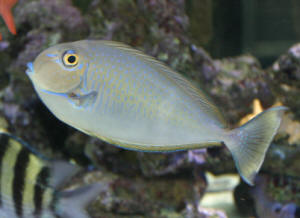
|
Crosshatch... trigger, Vlamingi tang incomp.
7/9/07 Hey guys, how's it going? Good I hope. So here's my
question. I have a 155 bow front established for about 6 yrs. For the
last 3 years I have 2 Vlamingi Tangs <Neat species, but need more
room...> and for about a year I have a male Crosshatch Trigger. They
have all gotten along very well. No problems during feedings or any
other aggressive behavior. Well yesterday I had the luck of coming
across a female Crosshatch, she was smaller than my male so I jumped on
the opportunity to get her. Well so far they are getting along perfect,
but now the male crosshatch is acting very aggressively towards the one
Vlamingi. I can only assume that he is a male, since they are both
young there hasn't been any way to tell. My question is, is this
normal behavior for a Crosshatch or just one male showing his dominance
to another? And do you think it will subside in time? Thank you. Jay
Uzzalinno <These more open-water species are indeed territorial...
and this is way too small a space psychologically... Maybe adding a
couple of "built up" arrangement of rock
("bommies") will alleviate this agonistic behavior for a
time... block the line of sight... Pile them well, and high... to the
surface if possible; and either start saving for a much larger system,
or plan to trade the Tangs in. Bob Fenner>
| Hole in the head ??????????????? Hello how are you ?
<Fine, yourself?> I am having trouble with one my fish a Naso
vlamingii I thing it is hole in the head but there is also some
white stuff were the hole is and also starting around the lateral
line and around the eye I really do not know what to do seems to
get worst and worst water quality is good all other fish have no
problem and I had this fish for around 2-3 years (picture attach to
this e-mail) what do you think ? <Is HLLE and some sort of other
involvement... likely all nutritional and environmental in
origin... Read here: http://www.wetwebmedia.com/hllefaqs.htm and the
materials archived on marine environmental disease... check,
improve water quality, bolster nutrition... Bob Fenner> |
|
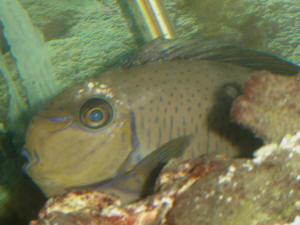
|
Naso Vlamingii I have the opportunity to purchase an adult
Naso Vlamingii. A very beautiful fish. I have 150 gal. tank. Do you
have any info. on this fish. And any suggestions on caring for this
fish? <<All sorts... one of the smaller Naso genus tangs at just
18" or so in length. An avid eater of all foodstuffs... needs some
greens in its diet daily. Lots of open tank space... high dissolved
oxygen... Brisk circulation. Bob Fenner>>
Surgeonfishes: Tangs for Marine Aquariums
Diversity, Selection & Care
New eBook on Amazon: Available here
New Print Book on Create Space: Available
here
by Robert (Bob) Fenner |
 |
|
|

